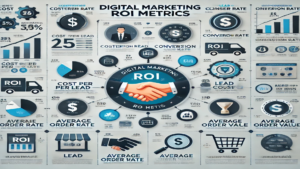To effectively measure the ROI of digital marketing efforts, it’s crucial to focus on key metrics that cut through the noise, enabling accurate tracking and assessment.
Here are 15 essential metrics to help determine digital marketing success and guide adjustments as needed.
Cost per Lead (CPL):
If the website collects leads, it’s important to know the cost per lead. A high CPL compared to the closed lead value suggests a lagging ROI.
This metric offers insights into the effectiveness of marketing efforts, helping inform strategic and budgetary decisions.
Lead Close Rate:
It’s essential to monitor the rate at which leads convert into customers, especially when analyzing offline and online data together.
Tracking this rate helps verify that digital marketing generates profitable leads and offers insights into sales team effectiveness.
Cost of Acquisition (COA):
Calculating the cost of acquisition, achieved by dividing total marketing costs by the number of generated sales, helps gauge ROI.
This is often calculated using CPA (Cost per Acquisition) models, allowing marketers to push for higher conversion rates and meet predetermined goals.
Average Order Value (AOV):
Focusing on average order value can boost revenue and streamline customer experience improvements.
A small rise in AOV can lead to significant new revenue, providing an effective means to maintain growth and profitability.
Conversion Rates by Channel:
With integrated marketing strategies, tracking channel-specific conversion rates identifies top-performing channels, whether organic, paid, or social media.
This helps optimize ROI by guiding investments toward channels that drive the most conversions.
Conversion Rates by Device:
Monitor conversion rates across devices (e.g., mobile, desktop).
If a device underperforms, consider reinvesting to optimize that channel, especially if traffic is rising.
This is particularly relevant for e-commerce, where mobile and tablet conversions are growing.
Exit Rate:
Track how many visitors leave the website from specific landing pages.
High exit rates can indicate pages needing conversion optimization. Use exit rates to prioritize landing pages for improvements in engagement and retention.
Blog Click-Through Rates (CTR):
Blogs help showcase brand expertise and drive site traffic.
By increasing blog CTR to the main site, achieve valuable business growth without incurring additional costs.
Customer Lifetime Value (CLV):
Calculated as Average Revenue per User (ARPU) x (1 / Churn Rate), CLV measures revenue potential over a customer’s lifetime.
Tracking this metric helps understand the long-term impact of marketing strategies.
Net Promoter Score (NPS):
NPS, based on a 1-10 scale, measures customer loyalty and likelihood to recommend a product.
Comparing promoters with detractors provides insights into satisfaction and helps refine customer service strategies.
Time invested vs. returns:
Assess the time employees invest in projects or campaigns to ensure it’s being allocated effectively.
Maximizing ROI involves directing team efforts toward high-impact initiatives.
Traffic-to-Lead Ratio:
Rising website traffic is a positive indicator, but the traffic-to-lead ratio (percentage of visitors converting to leads) provides deeper insight into campaign success.
Return on Advertising Spend (ROAS):
ROAS, or revenue from advertising divided by ad costs, reveals the effectiveness of paid campaigns.
Tracking ROAS assists with channel cost analysis and future performance projections.
Total Revenue:
Revenue tracking across campaigns, touchpoints, and marketing channels is crucial.
Ensure alignment between marketing and sales to establish accountability and track the impact of marketing activities on revenue.
Customer Retention Rate:
Measure the percentage of customers retained over a period using this formula:
Retention Rate = ((E – N) / S) x 100, where E is customers at the end of the period, N is new customers gained, and S is customers at the start.
High retention signals strong customer satisfaction and engagement.
As digital marketing evolves, these metrics are vital for demonstrating results and adapting strategies.

